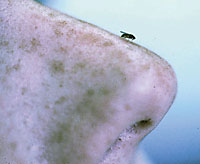 | Research led by John Carlson involved mapping the responses of the entire olfactory system of the fruit fly. The study provides insight into how animals respond to complex odors, and may later lead to more effective insect repellants. |
Yale scientists have systematically plotted the responses of the entire Drosophila (fruit fly) olfactory system, providing the first multi-dimensional map of the range of odorants sensed and the regions of the brain that are stimulated.
John Carlson, the Eugene Higgins Professor of Molecular, Cellular and Developmental Biology, and Elissa Hallem, his former graduate student in the Inter-departmental Neuroscience Program, published the comprehensive study in the journal Cell.
"The results of our analysis allow us to make predictions about which odors smell alike to an animal, and which smell different," says Carlson. "These predictions can now be tested in behavioral experiments and may help point us to insect attractants and repellants that are highly effective."
The study provides particular insight into the understanding of how animals perceive environmental smells that are often complex mixtures of molecular structures. It identifies compounds that both stimulate and inhibit response in odor neurons, and the differences in response that are due to concentration and duration of exposure to a compound.
"We were surprised to find that inhibitory responses are widespread among odor receptors," says Carlson. "Most receptors are inhibited by at least one odor, and most odors inhibit at least one receptor. Although previous work has been concerned mainly with excitatory responses of receptors, our results suggest that inhibition may play a major role in how odors are identified."
The research further shows how the responses of the receptor repertoire map into the brain. Surprisingly, receptors with similar odor specificities often map to widely separated locations and receptors with very different specificities often map to neighboring locations.
Carlson and Hallem, who have published extensively in this system over the past several years, found that individual receptors range along a continuum from "narrowly tuned" to "broadly tuned" to odorants. This finding moves the concept of the system beyond the previous picture of a simple dichotomy between specialist and generalist receptors.
Hallem is now a postdoctoral researcher at the California Institute of Technology in Pasadena, California. This work was funded by National Institutes of Health grants and by a National Research Service Award pre-doctoral fellowship.
-- By Janet Rettig Emanuel
T H I S
Research clarifies how animals
perceive environmental odors W E E K ' S
W E E K ' S S T O R I E S
S T O R I E S![]()
 University will review its Special Student Program
University will review its Special Student Program![]()
![]()
 Thirteen are honored for their work promoting town-gown cooperation
Thirteen are honored for their work promoting town-gown cooperation![]()
![]()
 Hu's speech to be broadcast, web-streamed
Hu's speech to be broadcast, web-streamed![]()
![]()
 A lesson in egg-drop engineering
A lesson in egg-drop engineering![]()
![]()
 YALE & CHINA: HISTORIC TIES, EXPANDING PARTNERSHIPS
YALE & CHINA: HISTORIC TIES, EXPANDING PARTNERSHIPS
 China Playing a Key Role in Internationalization of Yale
China Playing a Key Role in Internationalization of Yale![]()
 Conducting Collaborative Research
Conducting Collaborative Research![]()
 Promoting Health in China
Promoting Health in China![]()
 Living and Learning Together
Living and Learning Together![]()
 Preparing for China's Evolving Future
Preparing for China's Evolving Future![]()
 Forging Mutual Understanding: The Yale-China Association
Forging Mutual Understanding: The Yale-China Association![]()
 Looking Back: Yale & China
Looking Back: Yale & China![]()
![]()
 Symposium honors centennial of astronomy researcher
Symposium honors centennial of astronomy researcher![]()
![]()
 UAE minister speaks with Yale officials, students . . .
UAE minister speaks with Yale officials, students . . .![]()
![]()
 Foreign-language and self-guided audio tours of Yale campus . . .
Foreign-language and self-guided audio tours of Yale campus . . .![]()
![]()
 Research demonstrates that neurons in brain communicate . . .
Research demonstrates that neurons in brain communicate . . .![]()
![]()
 Symposium on 'Rethinking Historicism' honors Annabel Patterson
Symposium on 'Rethinking Historicism' honors Annabel Patterson![]()
![]()
 Peptide that functions like a nanosyringe offers new tool for drug delivery
Peptide that functions like a nanosyringe offers new tool for drug delivery![]()
![]()
 Research clarifies how animals perceive environmental odors
Research clarifies how animals perceive environmental odors![]()
![]()
 In Memoriam: William Sloane Coffin Jr.
In Memoriam: William Sloane Coffin Jr.![]()
![]()
 Graduating nursing student awarded Nightingale Scholarship
Graduating nursing student awarded Nightingale Scholarship![]()
![]()
 Yale Opera production will feature works by German composers
Yale Opera production will feature works by German composers![]()
![]()
 Next Dean's Workshop will explore flow cytometry research
Next Dean's Workshop will explore flow cytometry research![]()
![]()
 Center to mark anniversary of city's Holocaust Memorial
Center to mark anniversary of city's Holocaust Memorial![]()
![]()
 Five-year grant supports surgeon's work to develop . . .
Five-year grant supports surgeon's work to develop . . .![]()
![]()
 Event to celebrate students' written stories about their nursing experiences
Event to celebrate students' written stories about their nursing experiences![]()
![]()
 Campus Notes
Campus Notes![]()
![]()
 Correction
Correction![]()
Bulletin Home |
| Visiting on Campus
Visiting on Campus |
| Calendar of Events
Calendar of Events |
| In the News
In the News![]()
Bulletin Board |
| Classified Ads
Classified Ads |
| Search Archives
Search Archives |
| Deadlines
Deadlines![]()
Bulletin Staff |
| Public Affairs
Public Affairs |
| News Releases
News Releases |
| E-Mail Us
E-Mail Us |
| Yale Home
Yale Home